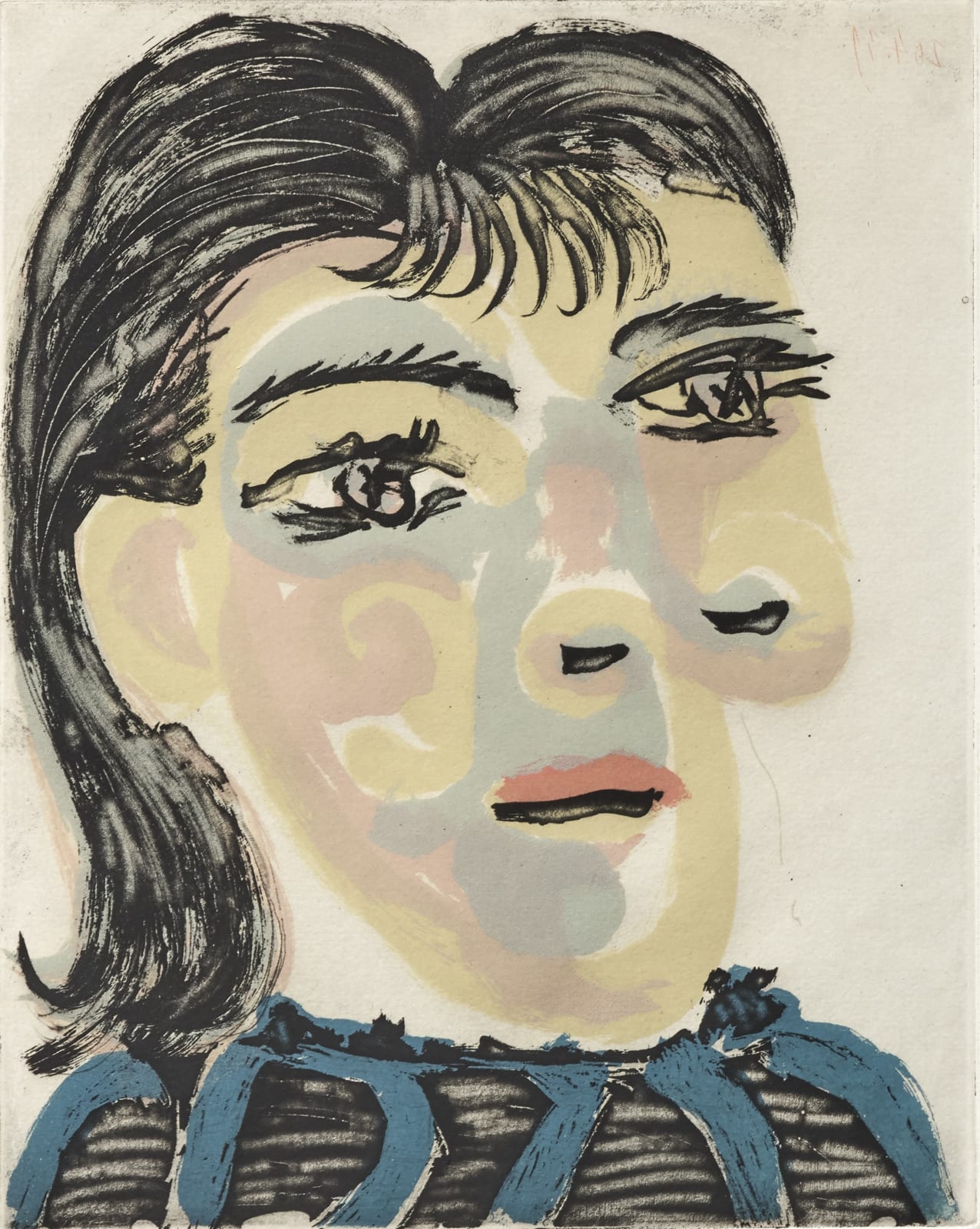Œuvres
Pablo Picasso Spanish, 1881-1973
Encadré : 66 x 55 cm
Plus d'images
Aquatint : Goya was the first to use it to translate his nightmarish visions with even more vigour and spontaneity. The Romantic painters found in it the ideal means of portraying the atmosphere of a landscape, and Rouault used it to set, in the manner of a stained-glassed window, the colours of his mystical images, with a large and powerful brushstroke of wash aquatint. For Picasso, this process became the element of choice, capable of associating an incredible variety of techniques to engrave, to bite and scratch, all used with a simmering passion and the resulting image always combining playfulness and serenity. Picasso loved using aquatint as the tones obtained could be superimposed on several marked plates of the same dimension to transcribe, during printing, an infinite variety of colour hues. Aquatint wash added a poetic, tactile and living dimension to the brushstroke.
Lorsque Paul Eluard a présenté Dora Maar à Picasso en 1935, au café des Deux Magots à Paris, elle était une célèbre photographe. Elle est devenue son amie, compagne et muse inspirante. Ce fut l'une des périodes les plus sombres de l'œuvre de Picasso, marquée par la guerre civile espagnole et la Seconde Guerre mondiale. Chaque période de la vie de Picasso a inspiré de nouvelles recherches, alimentant sa créativité et son imagination. La période de Dora Maar ne fut pas une exception. En ces temps difficiles, cette belle femme a pris l’apparence de La Femme qui pleure, ou Femme assise ou Femme au chapeau, devenant le pivot de toutes ces métamorphoses, du plus classique des portraits au plus irréel. Dora Maar sera toujours "La femme qui pleure" de 1937. Picasso a dit de Dora Maar: "Pour moi, c'est une femme qui pleure. Pendant des années, je l'ai peinte sous des formes torturées, pas à cause du sadisme ou du plaisir. Je ne pouvais que reproduire la vision qui m'est venue, celle de la vérité profondément enracinée de Dora ".
Aquatinte: Goya a été le premier à l'utiliser pour traduire ses visions cauchemardesques avec encore plus de vigueur et de spontanéité. Les peintres romantiques y trouvèrent le moyen idéal pour représenter l'atmosphère d'un paysage, et Rouault l'utilisa pour définir, à la manière d'un vitrail coloré, les couleurs de ses images mystiques, avec un large et puissant coup de pinceau d'aquarelle. Pour Picasso, ce processus est devenu un élément de choix, capable de combiner une incroyable variété de techniques pour graver, mordre et gratter, le tout utilisé avec une passion latente et l’image résultante qui allie toujours enjouement et sérénité. Picasso adorait utiliser l’aquatinte car les tons obtenus pouvaient être superposés sur plusieurs planches marquées de la même taille afin de retranscrire, lors de l’impression, une infinie variété de nuances de couleurs. au coup de pinceau.
Provenance
Galerie 27, Paris (Lionel Prejger)
Catalogues
Picasso, Chefs-d'œuvre du Musée national Picasso, Paris, Seattle Art Museum, 8 octobre 2010 - 17 janvier 2011 et Virginia Museum of Fine Arts, 19 février - 15 mai 2011, reproduits p.164 (n ° d'inventaire MP 2863)
Brigitte Baer, peintre-graveur Picasso. Tome III, 1935-1945, Editions Kornfeld, 1985, n ° 650, repr. p. 185.
Georges Bloch, Pablo Picasso, catalogue de l'œuvre gravé et lithographié, tome I, 1904-1967, éditions de Berne, Kornfeld & Klipstein, 1968, n ° 1340. Reproduit en pleine page en couleurs p. 41
Join our mailing list
* denotes required fields
We will process the personal data you have supplied in accordance with our privacy policy (available on request). You can unsubscribe or change your preferences at any time by clicking the link in our emails.





